Realm was a steadily good fanzine from the early seventies, with a wide variety of stellar contributors, and issue 5 was no different!
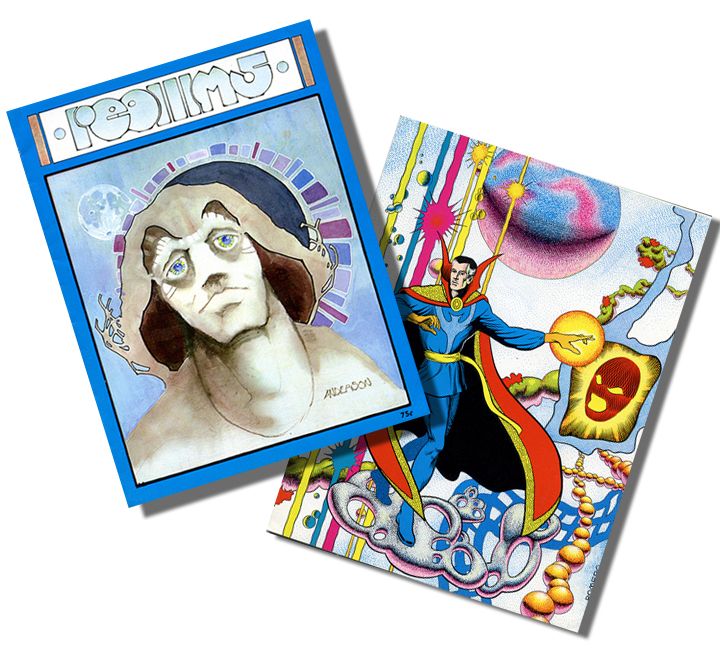
Realm 5: October 1972
Editor and publisher: Ed Romero
 Realm is one of those zines I wish I had more copies of. I have vague memories of a few of the covers shown in this issue in a house ad…but the only reason I was lucky enough to have one is the generosity of Jim Main, who loaned me this issue (and a few other zines). I am also grateful to publisher Ed/Artie Romero, who I purloined a copy of the most recent issue from, number 8. More on that later.
Realm is one of those zines I wish I had more copies of. I have vague memories of a few of the covers shown in this issue in a house ad…but the only reason I was lucky enough to have one is the generosity of Jim Main, who loaned me this issue (and a few other zines). I am also grateful to publisher Ed/Artie Romero, who I purloined a copy of the most recent issue from, number 8. More on that later.
This fanzine is one of those that had a pretty good variety of material, including pin ups, spot illustrations, comic stories, prose, interviews, and articles covering various topics. Helping Ed (who now goes by Artie, which I will refer to him as from now on) were his compatriots Darrel Anderson and Dave Taylor. While we are on the subject of Artie’s name change, let the horse who sports the name explain it.
I was named after my father, and my name was Artie Edward Thomas, Jr. My mother wanted to call me Eddie when I was little to avoid confusion. So I went by Ed Romero up until high school, when I stopped correcting my teachers who tried to call me Artie. So of course I became Artie to everyone outside of my family. When I got into fandom in 1968 I went by Ed Romero (I had been adopted by my step father, Jose Santiago Romero). Again, my mother encouraged me to sign my fan art Edward Romero. It took me a while to get all that straightened out. Everybody now calls me Artie!
As for how this issue progresses,  as you can see at the top, Anderson did the cover (with a nice Dr. Strange from Romero on the back cover), and the very next thing you see when you open up the first page is the beautiful (as usual) illustration (above) by Mike Kaluta (who also has a letter in the letter column). Luckily, Artie also provides a detailed breakdown of all the illustrations sprinkled throughout the issue (and there are a lot). Of course, anyone can recognize Vaughn Bode, who appears smack dab on page 1, along with a nice little photo of the home team seen at right (left to right, is Dave Taylor, Artie Romero, and Jeffrey May).
as you can see at the top, Anderson did the cover (with a nice Dr. Strange from Romero on the back cover), and the very next thing you see when you open up the first page is the beautiful (as usual) illustration (above) by Mike Kaluta (who also has a letter in the letter column). Luckily, Artie also provides a detailed breakdown of all the illustrations sprinkled throughout the issue (and there are a lot). Of course, anyone can recognize Vaughn Bode, who appears smack dab on page 1, along with a nice little photo of the home team seen at right (left to right, is Dave Taylor, Artie Romero, and Jeffrey May).
The first bit of actual content is an interesting story by Gary Brown and Doug Potter, Rainmaker, based on a Harry Nilsson/Bill Martin song. Visually told in a Carl Barks style, complete with ducks, I was struck by the really clear and well constructed layouts…more complex than I would expect, considering that Potter is aping the style of Carl Barks so closely. See what I mean below.
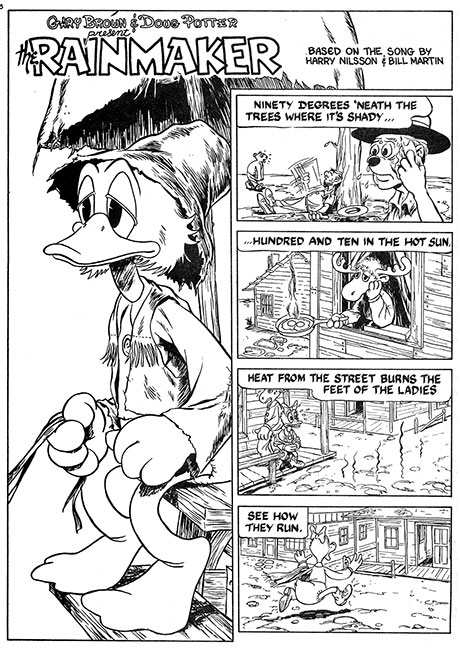
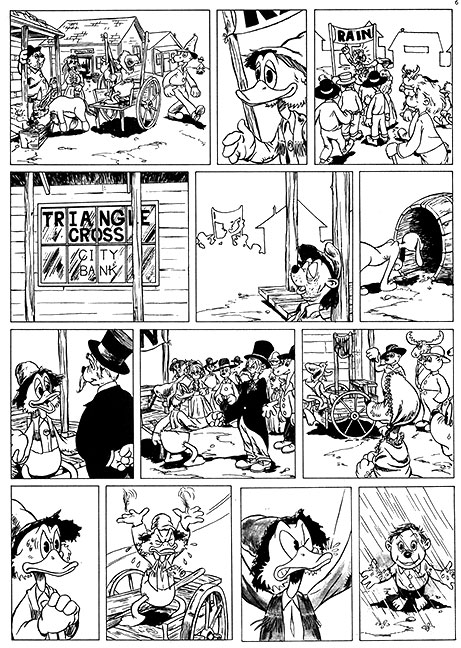
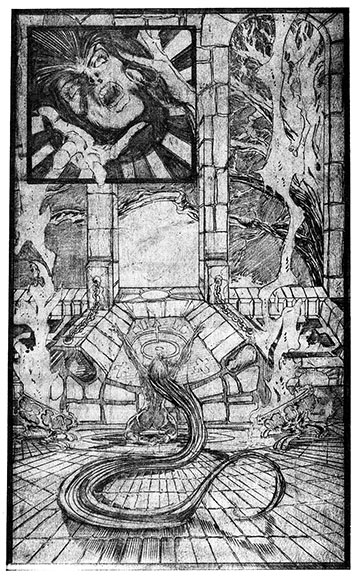 Next up is a reprinted Ray Bradbury interview by Marc Shapiro, and then the letters page (which has a pretty impressive bunch of spot illustrations by Kelly Freas, Alan Weiss, Tim Kirk, Dan Adkins, Carl Barks, Roy Krenkel and others). The next actual content is a story by Jeffrey May called The Guardian. What really floored me is that the illustrations are by a very young Barry Smith! Artie told me via Facebook that “those were practice pages Barry drew to show publishers that he could illustrate classic sword & sorcery stuff, and he sold them to me for just a few bucks at a convention, since he considered them throwaways. Jeffrey May looked at the art while he was writing his short story for issue 5, and we agreed that it could be used as spot illustrations for Jeff’s story. They worked out pretty well.” You can see one at left.
Next up is a reprinted Ray Bradbury interview by Marc Shapiro, and then the letters page (which has a pretty impressive bunch of spot illustrations by Kelly Freas, Alan Weiss, Tim Kirk, Dan Adkins, Carl Barks, Roy Krenkel and others). The next actual content is a story by Jeffrey May called The Guardian. What really floored me is that the illustrations are by a very young Barry Smith! Artie told me via Facebook that “those were practice pages Barry drew to show publishers that he could illustrate classic sword & sorcery stuff, and he sold them to me for just a few bucks at a convention, since he considered them throwaways. Jeffrey May looked at the art while he was writing his short story for issue 5, and we agreed that it could be used as spot illustrations for Jeff’s story. They worked out pretty well.” You can see one at left.
While we are on the subject of young creators, when I asked Artie about his early memories of comics and such, he told me
I started reading Marvel comics in 1966 when I was 14. I was totally obsessed with the work of Stan Lee, Steve Ditko and Jack Kirby. I tried drawing some of my own, but I found that I wasn’t a good enough artist to really pull it off. I got a letter published in Nick Fury, Agent of S.H.I.E.L.D #4 in 1968. They published my address in the letters column, and that got me into comics fandom. I was offered a co-editor position with Carl Gafford’s zine Minotaur that fall, and in January, 1969 I edited and published my first zine, Platinum Toad #1. I published Realm #1 (The first issue was titled Fantasy Realm) in the summer of 1969 at the age of 17.
Story number two is by editor Romero…a short one, but this first page shows off his detailed stippling style really well.

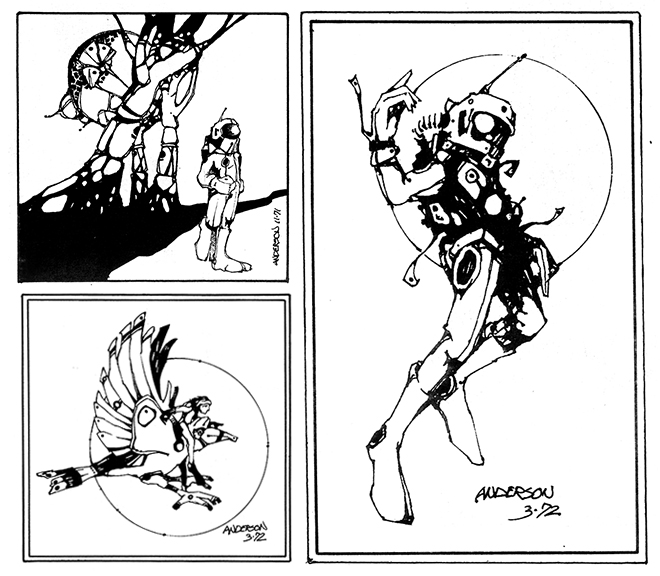 A Berni Wrightson checklist is next, followed by a portfolio by second in charge, Darrel Anderson. Above are a few pieces from that section.
A Berni Wrightson checklist is next, followed by a portfolio by second in charge, Darrel Anderson. Above are a few pieces from that section.
Artie talks about meeting his pals, saying
I met Darrel Anderson in high school in Colorado Springs, 1968, as well as Tom Haber and William Kirk Kennedy. We were all art nerds and comics fans. David Gregory Taylor met me while we were both attending MSU in Springfield, Missouri, about 1971.” Darrel has gone on to be an incredible digital artist (maintaining a partnership with illustrator Rick Berry on the website Braid. As for the reason for starting a zine in the first place, Artie said “I really wanted to do something different, something to make my mark in the world. Platinum Toad was inspired by my having seen many underground comix and newspapers, and just wanting to be in that scene. Realm was an attempt to make a more commercial, mainstream zine.
Romero has a review column following the portfolio, then George Proctor covers the Mid America Con (with accompanying photos and some art by Corben buddy, Herb Arnold of convention runner, Ken Keller). The next bit of continuity is a story by Dick Addison and moodily illustrated by Dave Taylor entitled Elyth. Here are a few pages to titillate you with (get it all on the pdf).


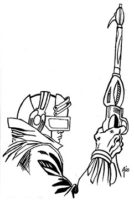 Jeffrey May follows with a short column about fan fiction,
Jeffrey May follows with a short column about fan fiction, 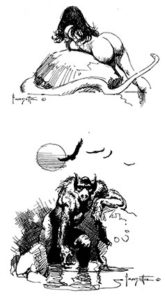 and that is followed by a story called A Place for Everything by Jan Strnad, who went on to do such an amazing body of work with Richard Corben. Jan was darn good even way back then (at this time, Corben had already started doing his ground breaking color underground comix work, much of it with Jan). Speaking of history, Artie replied to my question regarding his history, with
and that is followed by a story called A Place for Everything by Jan Strnad, who went on to do such an amazing body of work with Richard Corben. Jan was darn good even way back then (at this time, Corben had already started doing his ground breaking color underground comix work, much of it with Jan). Speaking of history, Artie replied to my question regarding his history, with
In 1969 I got a copy of Wally Wood’s Witzend and I freaked out! I had not yet seen an underground comic book and Witzend introduced me to Vaughn Bode and Jeffrey Jones, among others. I was into the counterculture and it seemed that Wood had tapped into something really powerful. In 1970 I started college and started attending comics conventions in the midwest. There I saw zines like Promethean Enterprises, Spa Fon and others that were really exceptional. I wanted to do something that I could hold up alongside those books and proudly say, I did this.
Ed has a portfolio next, showcasing his aforementioned style and his fascination with robots and science fiction in general. See below.
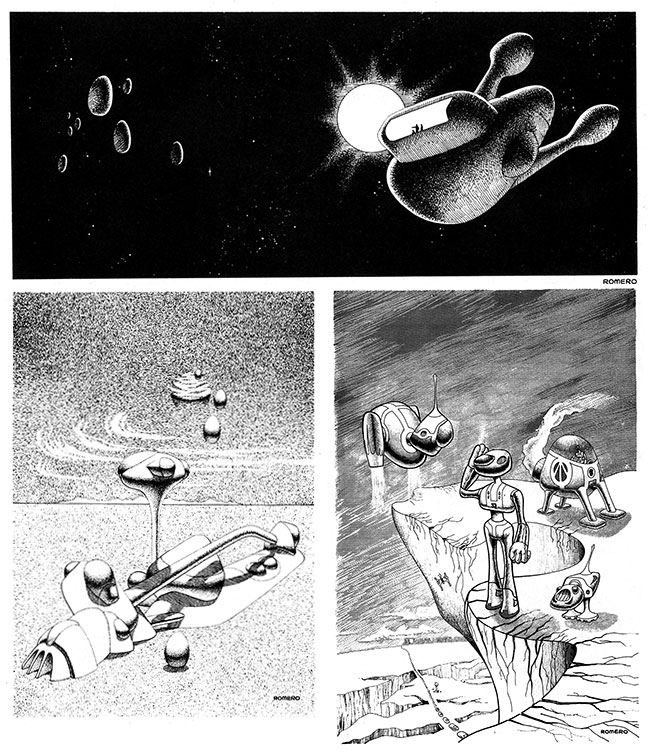
Speaking of Richard Corben, the following article features a nice visit Romero and Taylor had with the master of light, shade, and color.  Publishing a fanzine brings you into contact with a plethora of creators, readers and other individuals. It can be hard to keep up with people in a more average life, but it might be even harder for someone in a life peopled with such a roller coaster of friendships. Romero says that
Publishing a fanzine brings you into contact with a plethora of creators, readers and other individuals. It can be hard to keep up with people in a more average life, but it might be even harder for someone in a life peopled with such a roller coaster of friendships. Romero says that
I went through a lot of phases, the first being a Marvel Comics fan, then a fan of undergrounds, then I jumped into animation and video games. As I dropped out of one subculture and drifted into another, I usually left a lot of contacts behind. People from phase one remember me as Ed Romero, and everybody else knows me as Artie. Plus I went through a hippie phase from 1972 until about 1981 or so, and for somebody who started out as a Boy Scout and a Junior ROTC sergeant, you can see how staying in touch wouldn’t work well. My artistic circle mostly includes people I met in high school, people I interviewed and published in Cascade Comix Monthly and the other Everyman Comics, and a lot of people I’ve worked with in film and animation. Facebook has been great at reconnecting me with people like Bud Plant, Bob Beerbohm and others I met in fandom. It’s a huge time sink, but I love it!” The photo above shows a few of his compatriots, left to right, Rick Berry, William Kirk Kennedy (1953-2010), Darrel K. Anderson, Artie, and some frozen dude. He goes on to say “publishing fanzines and amazines definitely helped prepare me for my later endeavors. It made me a better writer, taught me about printing and publishing, and helped me learn how to organize and execute a large project. I had a lot of success publishing underground comix and Cascade Comix Monthly, one of the only underground fanzines, then became an animation producer. So yeah, editing and publishing Realm was the start of everything.
Realm had a pretty good run. Also, keep in mind that, although it started waaaay back then, Artie has actually published a few issues in this last decade or so. First though, a bit of history of Realm:
Realm 5, October 1972 was the last issue published as a fanzine. In that issue’s editorial I announced that the next issue would be a comic book. It took a while, but in October, 1975 I printed the guts of Realm 6; 48 pages of black and white comics drawn by my studio mates and me. I couldn’t afford to print slick, 4-color covers, so I bought a ream of slick paper and Darrel and I silkscreened covers in our kitchen on Cascade avenue in Colorado Springs in February, 1976. We took them to Berkeley Con in April, where Harvey Kurtzman and Sergio Aragones raved over what we had done. In 1977 we published a science fiction comics issue, Realm 7, which was the last issue until 2016, when Phantasy Press published Realm 8, a “Best of Everyman Comics” issue. Rick Berry graced us with some really great covers for that issue. That one is the only one still in print.
Speaking of issue 8, check out a bit of temptation below. The color images are the front and back covers from issue 8, fun and beautiful work by the always amazing Rick Berry. I asked Rick about the technique behind these via Facebook and he said “pencil, china white, india ink, scan into photoshop, manipulate, print onto toned canson paper, then watercolor canson print, scan again and finish in photoshop.” The other pages showcase the irreverent type of fun you would see in Artie’s beloved undergrounds.

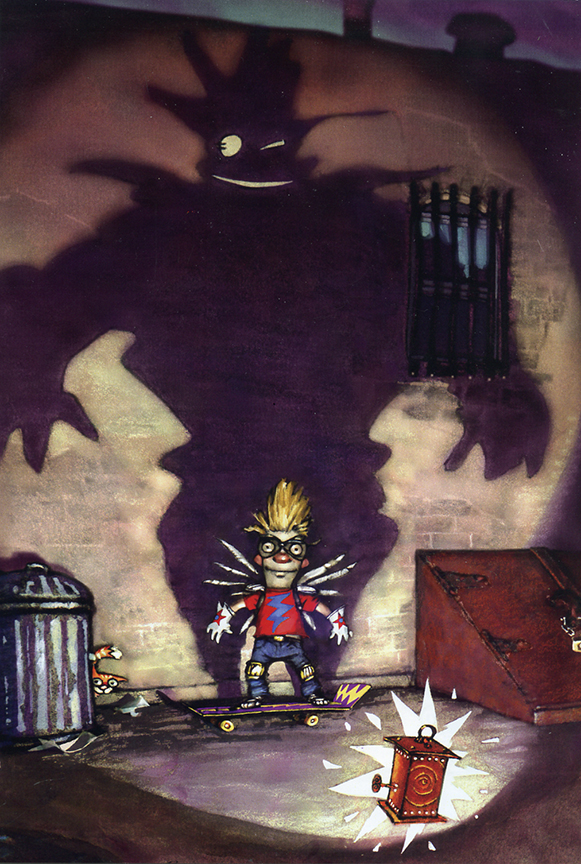

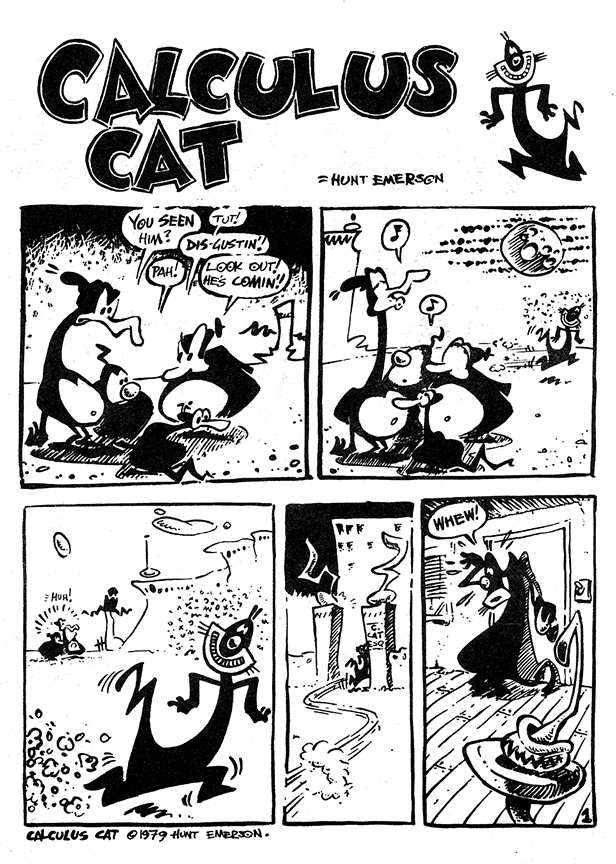


Plus, as another added bonus from the affable and multitalented Berry, here are a few unpublished images from his skateboard kid saga.
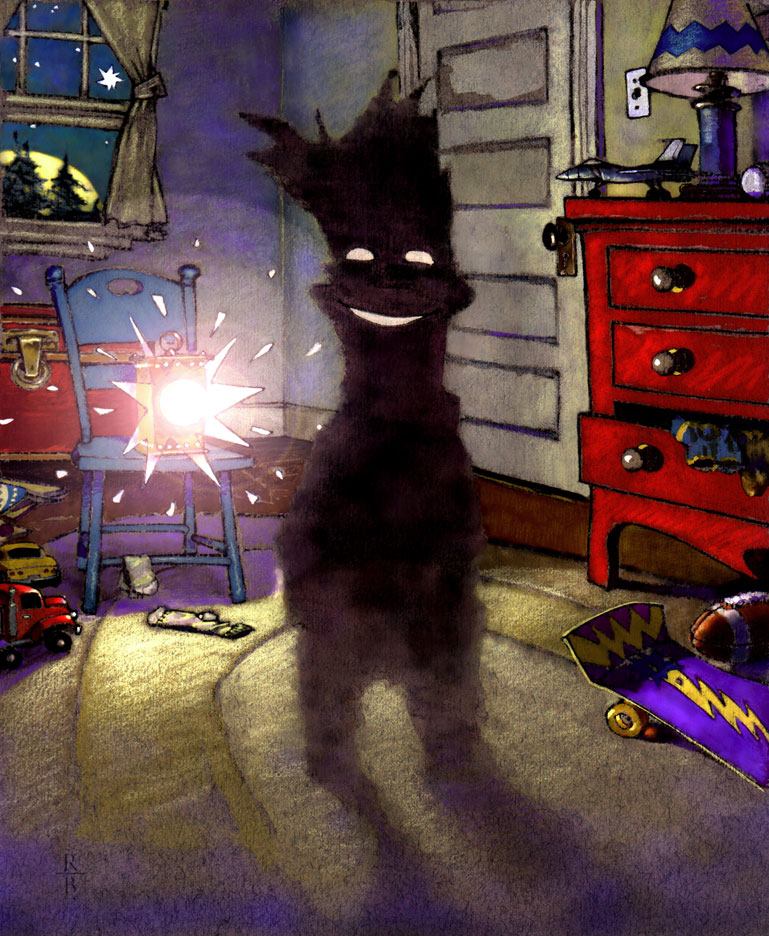
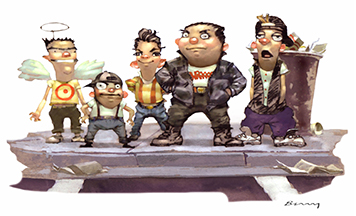
Keep in mind that Romero did publish other zines, a few that he has mentioned (and he contributed to many more). He fills us in a bit with “I am very fond of the later issues of Realm, but, the other thing of which I am proud is Cascade Comix Monthly, which I edited and published from March, 1978 until spring of 1981. There is a pretty good list of my publications and significant contributions to other books on Wikipedia under Artie Romero.” And of course, please check out his various sites for a great variety of work, such as ArtieStick.com, his personal site, a great catalog with links, and of course, his shop!
So, another Ink Stains bites the dust! Thanks to Artie especially, for taking the time to answer my questions (and to Rick Berry too, for doing the same to a lesser degree). And of course, don’t forget to go to my site so you can download the whole freaking isssue!
Later, gators!
Ken Meyer Jr.
kenmeyerjr@yahoo.com


Ken, I have to thank you for such a wonderful investigation of that place and time. Those artists with whom I got to share company provided the crucible of my aesthetic direction and inspiration. I’ll never stop owing them; it is a happy debt.
Cool bro!
Wish these could be put out in several collected editions so I could flip through the pages too! But thanks for putting them all here, Ken!